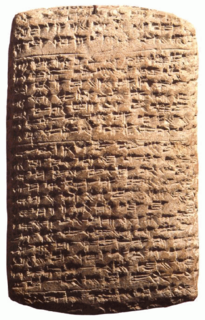
Rib-Hadda was king of Byblos during the mid fourteenth century BCE. He is the author of some sixty of the Amarna letters all to Akhenaten. His name is Akkadian in form and may invoke the Northwest Semitic god Hadad, though his letters invoke only Ba'alat Gubla, the "Lady of Byblos".
DU–Teššup was the son of Aziru, of the 1350–1335 BC Amarna letters correspondence, and also the father of Aziru's successor, in Amurru. DU-Teššup's name refers to the Hurrian god of sky and storm, Teshub.

The Pítati (pí-ta-ti) were a contingent of archers of ancient Egypt that were often requested and dispatched to support Egyptian vassals in Canaan. They are recorded in the correspondence of the 1350 BC Amarna letters, and were often requested to defend against the Habiru, also rogue vassal-kings and foreign troops of neighboring kingdoms, who were on the attack.

Ayyab was a king of Aštartu, named Tell 'Aštara, during the Amarna letters correspondence of 1350-1335 BC,. His city is located south of Damascus-(called Dimasqu in the letters), and is involved with the takeover of cities by the Habiru of the Amarna letters intrigues. Besides foreign countries to the north, for example Hatti of the Hittites, the internal Habiru were affecting cities/city-states, and their kings.
Biridašwa was a mayor of Aštartu, (Tell-Ashtara), south of Damascus,, during the time of the Amarna letters correspondence, about 1350–1335 BC. A second mayor of Aštartu, Ayyab, existed in this short 15–20 year time period.
Etakkama, as a common name, but also, Aitukama, Atak(k)ama, Etak(k)ama, and Itak(k)ama is the name for the 'mayor' (king) of Qidšu, (Kadesh) of the 1350-1335 BC Amarna letters correspondence.. Etakkama is referenced in 11 of the 382 EA letters,, and especially, a series of 4 identical letters concerning: Amqu, the region of the Beqaa in Lebanon. Those 4 letters concern the intrigues of city/city-state takeovers, along with troops from Hatti, and the claim of: Etakkama's troops from 'Kinsa' -(Qidšu-Kissa)-Kadesh) and are titled: "A joint report on Amqu (1-4)".
Niya, Niye, and also Niy of Thutmose I's Ancient Egypt, also Nii of the Amarna letters, and Nihe, etc. was a kingdom in Syria, or northern Syria.

Pawura, and also: Pauru, Piwure, Puuru/Puwuru was an Egyptian official of the 1350-1335 BC Amarna letters correspondence. As mentioned in letter no. 171, he was also an Egyptian "archer–commander". In letter no. 289 he is called an "irpi–official". In Egyptian his name means 'the Great One', (Pa-wr/Pa-ur)(letter EA 287:45-"1.-Pa-Ú-Ru")

Tunip was a city-state in western Syria in 1350–1335 BC, the period of the Amarna letters. The name "Syria" did not yet exist, though this was already the time of ancient Assyria. The regions were: Amurru, Nuhašše, the Amqu, Nii, etc.
Abimilku around 1347 BC held the rank of Prince of Tyre, during the period of the Amarna letters correspondence. He is the author of ten letters to the Egyptian pharaoh, EA 146-155. In letter EA 147, Pharaoh Akhenaten confirmed him as ruler of Tyre upon the death of his father, and in EA 149, referred to him with the rank of rabisu (general).
Haapi, also Haip and Ha'ip was a commissioner of the 1350-1335 BC Amarna letters correspondence. The name "Hapi" in Egyptian is the name for the Nile god Hapi.
Ili-Rapih was the follow-on mayor in Gubla-(modern Byblos), and the brother of Rib-Hadda, the former mayor of Gubla, ; Ili-Rapih is in the 1350-1335 BC Amarna letters correspondence, and wrote 2 follow-on letters to the Pharaoh after the death of Rib-Haddi.
Zita was a Hittite prince and probably the brother of Suppiluliuma I,, in the 382–letter correspondence called the Amarna letters. The letters were mostly sent to the pharaoh of Egypt from 1350-1335 BC, but other internal letters, vassal-state letters, and epics, also word texts, are part of the letter corpus. Zita had a son called Hatupiyanza.

The Salhi is a region/city-state in the vicinity of Ugarit during the 15-20 year Amarna letters correspondence of 1350-1335 BC.

Amarna letter EA 161, titled: An Absence Explained, is a tall clay tablet letter of 8 paragraphs, with single paragraphing lines. The surface is somewhat degraded, but most cuneiform signs that remain, allow for a relative complete translation context for the letter, and the eight paragraphs. The clay tablet is no. BM 29818 at the British Museum; the number is visible at the top of the tablet, above Para I-(in black ink, the top half of the number visible).

Amarna letter EA 149, titled: "Neither Water nor Wood" is a moderate- to extended-length clay tablet Amarna letter from Abimilku of Tyre-(called Ṣurru in the letters), written to the Pharaoh of Egypt.

Amarna letter EA 59, titled: "From the Citizens of Tunip" is a short-, to moderate-length clay tablet Amarna letter from the city-state of Tunip, written to the Pharaoh of Egypt. Only one other city sent a clay tablet Amarna letter to the Pharaoh, namely Irqata, letter EA 100, titled: "The City of Irqata to the King".

Amarna letter EA 156, titled: "Aziru of Amurru" is a very short letter from Aziru, the leader of the region of Amurru. EA 156 is the first letter in a series of 16 letters regarding Aziru.

Amarna letter EA 158, titled: "Father and Son" is a moderate length letter from Aziru, the leader of the region of Amurru. The letter is written to the Egyptian official, Tutu/ (Dudu). EA 158 is the third letter in a series of 16 letters regarding Aziru.

Amarna letter EA 170, titled: "To Aziru in Egypt" is a moderate length letter, from Aziru, the leader of the region of Amurru. EA 170 is the fifteenth letter in a series of 16 letters regarding Aziru.








